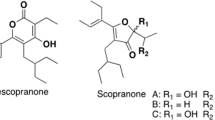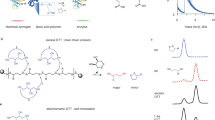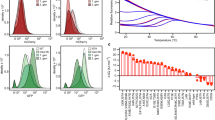Abstract
The crystal structure of a novel esterase from Streptomyces scabies , a causal agent of the potato scab disease, was solved at 2.1 Å resolution. The tertiary fold of the enzyme is substantially different from that of the α/β hydrolase family and unique among all known hydrolases. The active site contains a dyad of Ser 14 and His 283, closely resembling two of the three components of typical Ser-His-Asp(Glu) triads from other serine hydrolases. Proper orientation of the active site imidazol is maintained by a hydrogen bond between the Nδ-H group and a main chain oxygen. Thus, the enzyme constitutes the first known natural variation of the chymotrypsin-like triad in which a carboxylic acid is replaced by a neutral hydrogen-bond acceptor.
This is a preview of subscription content, access via your institution
Access options
Subscribe to this journal
Receive 12 print issues and online access
$189.00 per year
only $15.75 per issue
Buy this article
- Purchase on Springer Link
- Instant access to full article PDF
Prices may be subject to local taxes which are calculated during checkout
Similar content being viewed by others
References
Blow, D.M., Birktoft, J.J. & Hartley, B.S. Role of a buried acid group in the mechanism of action of chymotrypsin. Nature, 221, 337–340 (1969).
Kraut, J. Serine proteases: structure and mechanism of catalysis. A. Rev. Biochem., 46, 331–358 (1977).
Warshel, A., Naray-Szabo, G., Sussman, F. & Hwang, J.-K. How do serine proteases really work. Biochemistry, 28, 3629–3637 (1989).
Pauling, L. Molecular architecture and biological reactions. Chem. Engng. News, 24, 1375–1377 (1946).
Brady, L. et al. A serine protease triad forms the catalytic centre of a triglycerol lipase. Nature, 343, 767–770 (1990).
Winkler, F.K., D'Arcy, A. & Hunziker, W. Structure of human pancreatic lipase. Nature, 343, 771–774 (1990).
Schrag, J.D., Li, Y., Wu, S. & Cygler, M. Ser-His-Glu triad forms the catalytic site of the lipase from Geotrichum candidum. Nature 351, 761–764 (1991).
Sussman, J.L., et al. Atomic structure of acetylcholinesterase from Torpedo californica: a prototypic acetylcholine-binding protein. Science, 253, 872–879 (1991).
Lawson, D.M. et al. Structure of a myristoyl-ACP specific thioesterase from Vibrio harveyi. Biochemistry, 33, 9382–9388 (1994).
Hecht, H.J., Sobek, H., Haag, T., Pfeifer, O. & Pée, K.-H. The metalion-free oxidoreductase from Streptomyces aureofadens has an α/β hydrolase fold. Nature struct. Biol. 1, 532–537 (1994).
McQueen, D.A.R. & Schottel, J.L. Purification and characterization of a novel extracellular esterase from pathogenic Streptomyces scabies that is inducible by zinc. J. Bacteriol. 169, 1967–1971 (1987).
Raymer, G., Willard, J.M.A. & Schottel, J.L. Cloning, sequencing and regulation of expression of an extracellular esterase gene from the plant pathogen Streptomyces scabies. J. Bacteriol. 172, 7020–7026 (1990).
Ollis, D.L. et al. The α/β hydrolase fold. Prot. Engng. 5, 197–211 (1992).
Richardson, J.S. The anatomy and taxonomy of protein structure. Adv. Prot. Chem. 34, 167–339 (1981).
Leszczynski, J.F. & Rose, G.D. Loops in globular proteins: a novel category of secondary structure. Science, 234, 849–855 (1988).
Derewenda, Z.S. & Derewenda, U. Relationships among serine hydrolases: evidence for a common motif in triacylglyceride Upases and esterases. Biochem. cell Biol. 69, 842–851 (1991).
Rogers, G.A. & Bruice, T.C. Synthesis and evaluation of a model for the so-called ‘charge relay’ system of the serine esterases. J. Am. chem. Soc. 96, 2473–2481 (1974).
Zimmerman, S.C., Korthals, J.S. & Cramer, K.D. Syn and anti-oriented oriented imidazol carboxylates as models for the histidine-aspartate couple in serine proteases and other enzymes. Tetrahedron 47, 2649–2660 (1991).
Markley, J.L. & Ibanez, I.B. Zymogen activation in serine proteinases. Proton magnetic resonanse pH titration studies of the two histidines of bovine chymotrypsinogen A and chymotrypsin Aα . Biochemistry 17, 4627–4640 (1978).
Kossiakoff, A.A. & Spencer, S.A. Direct determination of the protonation states of aspartic acid-102 and histidine-57 in the tetrahedral intermediate of the serine proteases: neutron diffraction of trypsin. Biochemistry 20, 6462–6474 (1981).
Sprang, S. et al. The three-dimensional structure of Asn 102 mutant of trypsin: role of Asp 102 in serine protease catalysis. Science 237, 905–909 (1987).
Carter, P. & Wells, J.A. Dissecting the catalytic triad of a serine protease. Nature, 332, 564–568 (1988).
Frey, P.A., Whitt, S.A. & Tobin, J.B. A low-barrier hydrogen bond in the catalytic triad of serine proteases. Science, 264, 1927–1930 (1994).
Bachovchin, W.W. 15N NMR spectroscopy of hydrogen bonding interactions in the active sites of serine proteases: evidence for a moving histidine mechanism. Biochemistry 25, 7751–7759 (1986).
Hibbert, F. & Elmsley, J. Hydrogen bonding and chemical reactivity. Adv. phys. org. Chem. 26, 255–379 (1990).
Derewenda, Z.S. & Wei, Y. Molecular mechanism of enantiorecognition by esterases. J. Am. chem. Soc. in the press.
Derewenda, Z.S., Derewenda, U. & Kobos, P. Cε-H··O=C< hydrogen bond in the active sites of serine hydrolases. J. molec. Biol. 241, 83–93 (1994).
Zhou, G.W., Guo, J., Huang, W., Fletterick, R.J. & Scanlan, T.S. Crystal structure of a catalytic antibody with a serine protease active site. Science, 265, 1059–1064 (1994).
Green, R., Schottel, J.L., Swenson, L., Wei, Y. & Derewenda, Z.S. Crystallization and preliminary crystallographic data of a Streptomyces scabies extracellular esterase. J. molec. Biol. 227, 569–571 (1992).
Howard, A.J. et al. The use of an imaging proportional counter in macromolecular crystallography. J. appl. Crystallogr. 20, 383–387 (1987).
Sheldrick, G.M. Heavy atom location using SHELXS-90. in Proceedings of the CCP4 Study weekend, 23–38 (SERC Daresbury Laboratory, UK; 1991).
Otwinowski, Z. in Proceedings of the CCP4 study Weekend, 80–86 (SERC Daresbury Lab., UK; 1991).
Zhang, K.Y.J. SQUASH - Combining constraints for macromolecular phase refinement and extension. Acta crystallogr. D 49, 213–222 (1993).
Read, R.J. Improved Fourier coefficients for maps using phases from partial structures with errors. Acta crystallogr. A 42, 140–149 (1986).
Jones, T.A., Zou, J.-Y., Cowan, S.W. & Kjeldgaard, M.I. Improved methods for building protein models in electron density maps and the location of errors in these models. Acta crystallogr. A 47, 110–119 (1991).
Brunger, A.T X-PLOR Manual Version 3.1. (Yale Univ. Press, New Haven, CT, U.S.A; 1992).
Jones, T.A. A graphics model building and refinement system for macromolecules. J. appl. Crystallogr. 11, 268–272 (1978).
Hendrickson, W.A. Stereochemically restrained refinement of macromolecular structures. Meths Enzymol. 115, 252–270 (1985).
Laskowski, R.A., MacArthur, M.W., Moss, D.S. & Thornton, J.M. PROCHECK: a program to check the stereochemical quality of protein structures. J. appl. Crystallogr. 26, 283–291 (1993).
Carson, M. Ribbon models for macromolecules. J. molec. Graphics, 5, 103–106 (1987).
Nicholls, A., Sharp, K.A. & Honig, B. Protein folding and association: insights from the interfacial and thermodynamic properties of hydrocarbons. Proteins, 11, 281–296 (1991).
Kraulis, P.J. MOLSCRIPT: a program to produce both detailed and schematic plots of protein structures. J. appl. Crystallogr. 24, 946–950 (1991).
Bacon, D.J. & Anderson, W.F. A fast algorithm for rendering space-filling molecule pictures. J. molec. Graphics. 6, 219–220 (1988).
Author information
Authors and Affiliations
Rights and permissions
About this article
Cite this article
Wei, Y., Schottel, J., Derewenda, U. et al. A novel variant of the catalytic triad in the Streptomyces scabies esterase. Nat Struct Mol Biol 2, 218–223 (1995). https://doi.org/10.1038/nsb0395-218
Received:
Accepted:
Issue Date:
DOI: https://doi.org/10.1038/nsb0395-218
This article is cited by
-
CE16 acetylesterases: in silico analysis, catalytic machinery prediction and comparison with related SGNH hydrolases
3 Biotech (2021)
-
Structure-guided protein engineering increases enzymatic activities of the SGNH family esterases
Biotechnology for Biofuels (2020)
-
Structural insights into the molecular mechanisms of pectinolytic enzymes
Journal of Proteins and Proteomics (2019)
-
An effective approach for annotation of protein families with low sequence similarity and conserved motifs: identifying GDSL hydrolases across the plant kingdom
BMC Bioinformatics (2016)
-
Multifunctionality and diversity of GDSL esterase/lipase gene family in rice (Oryza sativa L. japonica) genome: new insights from bioinformatics analysis
BMC Genomics (2012)



